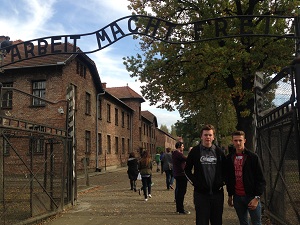King's Park Visit Auschwitz

On the seventh of October 2014, we travelled to Poland on a one day excursion to the former concentration camp of Auschwitz-Birkenau in southern Poland. It was a hugely emotional experience for both of us and it undoubtedly changed the way that we view the world and the people in it. The day began with an early morning flight from Glasgow airport to the Polish airport of Krakow. From Krakow we went by bus to a small Polish town called Oswiecm, which is situated close to Auschwitz I. We went to the site of the former great synagogue which was one of the most famous in Eastern Europe. The site is nothing more than a plot of land and we would not have been able to tell that it was such a famous and beautiful building prior to the war if we had not been informed. The town had a pre-war population of 58% Jews but following the war, only one Jew remained in the town, showing the sheer brutality of the Nazi regime in Poland. The last Jew in the town died in 2012 and now there are no remaining Jewish occupants.
From Oswiecm, we travelled to Auschwitz I which was a former Polish army barracks, being converted into a concentration camp following the Nazi occupation of Poland in 1939. It was a surreal experience to see this infamous site in the flesh, rather than simply in black and white photographs. In the camp we saw many artefacts from the camp which remained from the war, as well as the site of former Auschwitz commandant Rudolf Hess’ hanging. His family house was situated in close proximity to the camp and only metres away from the very first gas chamber used by the Nazis as part of their ‘final solution’ to the ‘ Jewish Question’. The most emotional part of Auschwitz I would have to be going into a gas chamber. Seeing the scratches on the walls and seeing the openings in the ceiling where the gas would have been dispersed from, was truly moving and emotionally scarring. To know that so many people’s lives ended in this small, claustrophobic square room is difficult to fully appreciate.
Following the visit to Auschwitz I, we again travelled by bus to Auschwitz II Birkenau, which was the camp set up to deal with the massive influx of Jews from across Europe. This camp is huge in comparison to Auschwitz I and has been unchanged, for the most part, since the way that it was found after the camp’s liberation by the Soviet Union in January 1945. Birkenau had four gas chambers, as well as countless small barracks where prisoners were forced to live. The conditions that they had to live under were horrific and outbreaks of disease were common. Birkenau is also the site of the train tracks and the ‘end of the line’. This was where thousands upon thousands of families were split up, never to see one another again. When the trains arrived, 70% of those who had made the long, uncomfortable journey across Europe were sent straight to the gas chambers, with only the very fittest and strongest being selected to do manual slave labour which would help drive the Nazi war machine. The majority of those who did this work died of disease, starvation or dehydration. To know that so many people were separated from their loved ones at this very site was truly heart-breaking. It was hard to comprehend the conditions that the people of the camp suffered, and both of us were in agreement about the fact that we couldn’t have done it ourselves. Again, this made us further appreciate our own lives, what we have and simply to be glad of the fact that we can see our loved ones on a daily basis. Auschwitz II Birkenau had four gas chambers during the war, 3 of which were destroyed by the Nazis in an attempt to cover up their inhumane actions. The other gas chamber was destroyed by an inmate uprising in 1944 and all of the prisoners who revolted were executed. Our visit to the camp fell 70 years to the day since the uprising took place and this only furthered our appreciation for the human spirit and how the inmates showed incredible courage.
The visit was extremely moving and was undoubtedly an experience that both of us will never forget. To say that it was life-changing would be an understatement as it is difficult to put into words the impact it had on us. We feel that we should share our experience with others, particularly those in younger generations who may have no knowledge about this truly shocking event in the history of mankind. We would also like to spread the word about the extremes to which people can go because of hatred and prejudice. The next holocaust may not be about the extermination of the Jews. It could be about the extermination of you and I. Lastly, we would like to thank the Lessons from Auschwitz Project and Mrs McNichol for providing us with this truly life-changing experience.